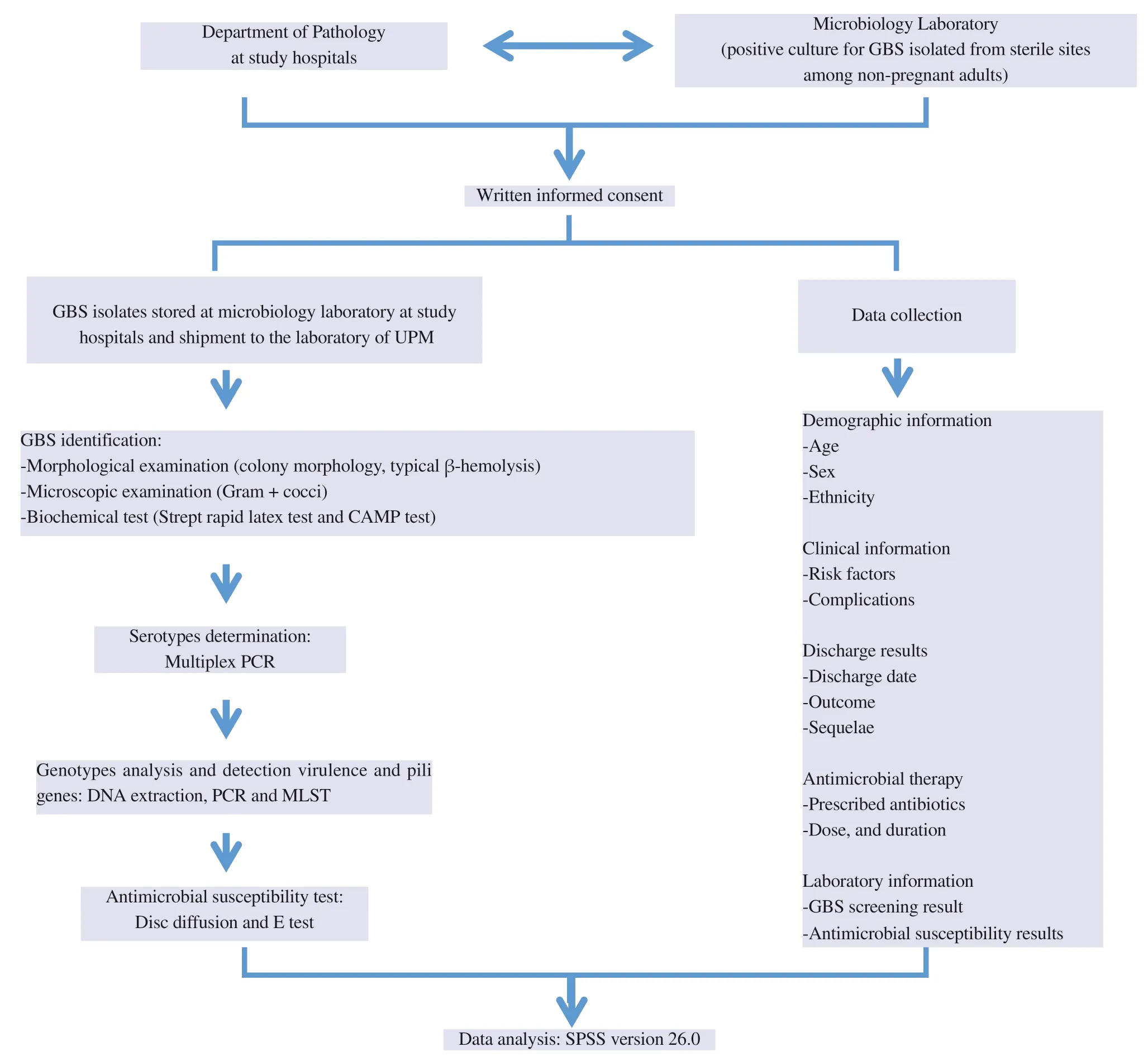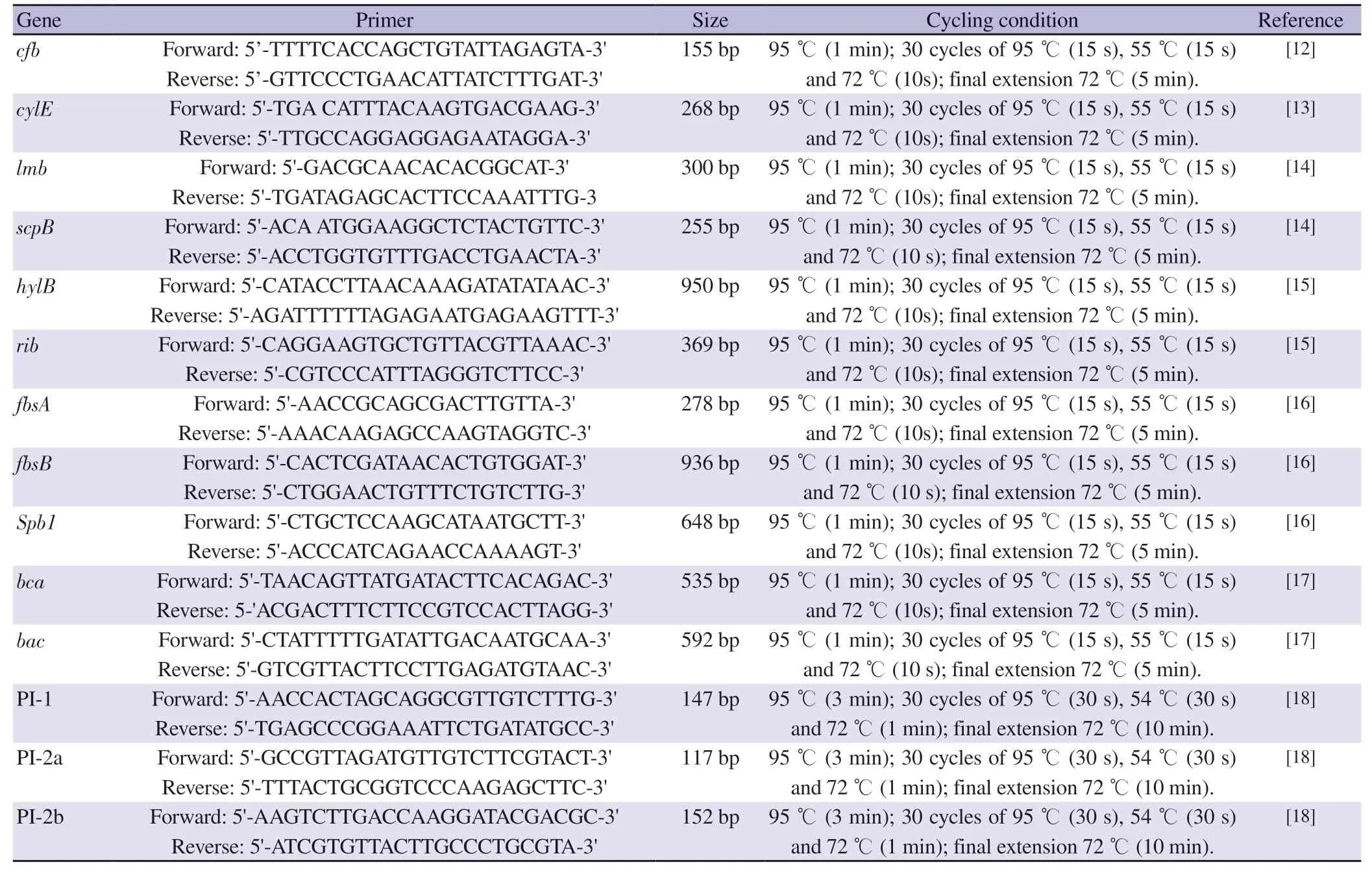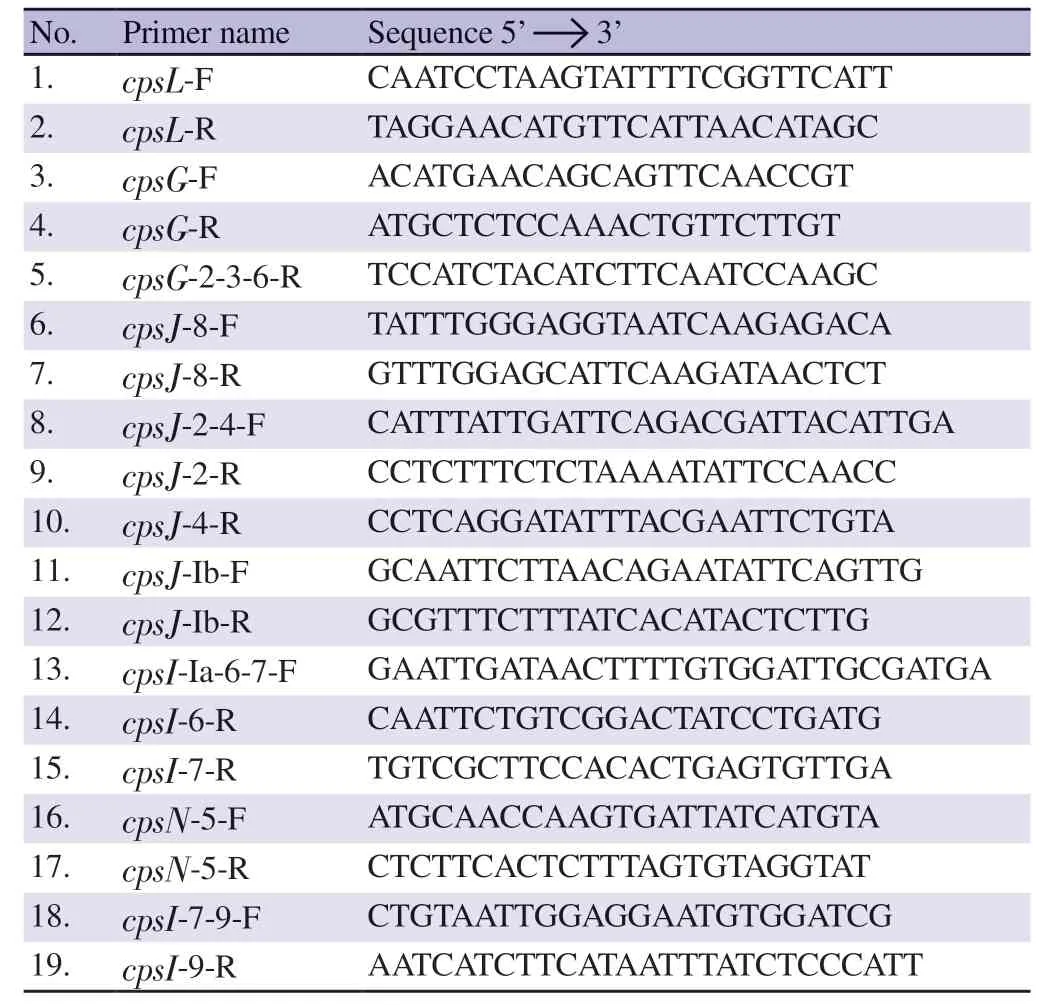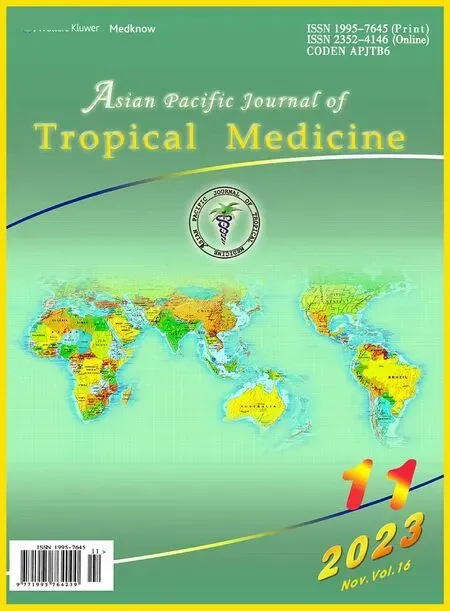Disease burden,antimicrobial resistance and molecular characterization of invasive group B Streptococcus among non-pregnant adults in Malaysia: A protocol study
Abdulrahman Muthanna ,Nurul Hana Zainal Baharin ,Mohd Nasir Mohd Desa ,Nurul Diana Dzaraly ,Mohammad Noor Amal Azmai ,Syafinaz Amin-Nordin
1Department of Biomedical Sciences,Faculty of Medicine and Health Sciences,Universiti Putra Malaysia,43400 Serdang,Selangor,Malaysia
2Department of Biology,Faculty of Science,Universiti Putra Malaysia,43400 Serdang,Selangor,Malaysia
3Aquatic Animal Health and Therapeutics Laboratory,Institute of Bioscience,Universiti Putra Malaysia,43400 Serdang,Selangor,Malaysia
4Department of Medical Microbiology,Faculty of Medicine and Health Sciences,Universiti Putra Malaysia,43400 Serdang,Selangor,Malaysia
5Department of Medical Microbiology,Sultan Abdul Aziz Shah Hospital,Universiti Putra Malaysia,Persiaran MARDI-UPM,43400,Selangor,Malaysia
6Laboratory of Vaccine and Biomolecules,Institute of Bioscience,Universiti Putra Malaysia,43400 Serdang,Selangor,Malaysia
ABSTRACT Objective: To determine the prevalence of group B Streptococcus(GBS) isolated from non-pregnant adults from seven major hospitals in Peninsular Malaysia;the incidence,case-fatality ratio,antimicrobial susceptibility patterns,serotype,genotype and distribution of the GBS virulence and pili genes are also investigated.Methods: This multicentre,prospective,observational study is conducted in seven major tertiary hospitals in Malaysia among non-pregnant adults.Simultaneously,a retrospective study is conducted in the selected hospitals with similar approaches.GBS isolates are subjected to phenotyping,serotyping by multiplex PCR,antimicrobial susceptibility testing and PCR-detection of GBS virulence and pilus genes.Seven housekeeping genes are amplified and sequenced for multi-locus sequence typing.Discussion: Findings from the study may contribute to the management of clinical practice to diagnose and prevent GBS related diseases in a timely manner.Prudent use of antibiotics is encouraged by monitoring antimicrobial resistance.
KEYWORDS: Group B Streptococcus;Incidence;Serotype;Antimicrobial resistance;Virulence gene;Multi-locus sequence typing
1.Introduction
Streptococcus (S.) agalactiae(also known as group BStreptococcusor GBS) belongs to group B of the Rebecca Lancefield classification of β-haemolytic streptococci.GBS is an opportunistic commensal Gram-positive coccus with a tendency to form chains that occur in 17%-30% of healthy human adults without symptomatic disease worldwide[1].Recently,the incidence of invasive GBS infection has increased among immunocompromised individuals and those with underlying medical conditions such as diabetes,heart disease,malignancies,and aging.GBS infections may result from hospitalacquired infection or,more likely,from preexisting colonization of the skin or mucous membrane,which causes numerous and varied clinical manifestations,including tissue and skin infections,septicemia,meningitis and others[2].In 2015,a rare outbreak of invasive disease due to the GBS serotype Ⅲ,ST283,occurred in Singapore due to consuming contaminated raw fish salad (yusheng)typically made from two freshwater fish species.The outbreak has infected 238 people and caused septic arthritis,meningitis,and septicemia among a very different group of non-pregnant adults.This was the first documented case of invasive GBS associated with foodborne transmission[3].
Significance
This study provides an overview of the methodological approaches for estimating invasive group BStreptococcusdisease burden,antimicrobial resistance,and molecular characterization.The outputs will help to improve clinical practice in diagnosis and treatment of group BStreptococcusdisease,as well as preventive measures to control disease recurrence.Monitoring antimicrobial resistance will promote the rational use of antimicrobials.
In Malaysia,literature search on GBS infection in humans has identified a low number of research articles since 1980s.Available studies described GBS infection and associated risk factors only at a specific location and time point.This may not represent the real incidence of GBS infection in Malaysia,where actual cases could have been under reported.
In view of the increasing incidence of treatment failure for GBS infection by antimicrobial therapy due to its concurrent emerging resistance,an understanding of the phenotypes and genotypes of GBS is warranted[4,5].Furthermore,antimicrobial resistance leads to increased morbidity and mortality since resistance increases the risk of inappropriate therapy[6].The risk is that the patients who do not receive appropriate therapy will have a longer period of disease or even life-threatening consequences;therefore,morbidity and transmission of the microorganism will increase due to the patients remaining infectious for an extended period[7].Also,the increasing trend of antimicrobial resistance is a serious challenge in countries at all economic levels[8].
Data on surveillance at the national level is urgently needed.Antimicrobial resistance needs to be monitored and the disease burden needs to be determined.As a result of the potential findings from this protocol study,clinical practice will be improved and optimal preventive measures can be developed.It will also be helpful to develop rational antimicrobial prescription guidelines based on data regarding antimicrobial resistance of the prevalent GBS.It will be possible to assess prospective interventions,including antimicrobial prophylaxis and future vaccine development based on the nationwide,population-based epidemiological data of the GBS infections.
2.Subjects and methods
2.1.Study objectives
The aim of this study is to present protocol for determining the prevalence of GBS isolated from non-pregnant adults from a setting model involving seven tertiary hospitals in major cities of Peninsular Malaysia.The expected outcomes include the incidence,casefatality ratio (CFR),antimicrobial susceptibility patterns,serotypes,genotypes and distribution of GBS virulence and pili genes.The study was retrospectively registered at https://register.clinicaltrials.gov on 02/11/2023,and was assigned the registration number"NCT05726006".
2.2.Study design,setting and population
This protocol is a multicenter,prospective,retrospective observational study involving seven major hospitals in Peninsular Malaysia.The inclusion criteria for hospital selection are large urban tertiary hospitals with adequate research capacity and facilities to conduct the study,such as adequate laboratory facilities and competent staff to identify,process and store GBS isolates.Maximum coverage is ensured by choosing hospitals within a dense population.The study population consists of all non-pregnant adult patients from the selected hospitals for whom GBS is isolated from their clinical samples from sterile sites (blood,cerebrospinal fluid,internal tissue,pus aspirate,peritoneal dialysis fluid,bone biopsy,skin biopsy and bone marrow).Repeated GBS that is isolated from the same patient in the same admission and non-sterile site isolates is excluded.In the case of several simultaneous invasive infections occurring in the same patient,only the most profound infection is retained.Restricted medical records associated with the isolates are provided by the respective participating hospitals: site of isolation (blood,cerebrospinal fluid,internal tissue,pus aspirate,etc.),demographic data (age,sex,ethnicity),clinical manifestations(risk factors,comorbidities,complications,death),discharge results (discharge date,outcome,and sequelae),antimicrobial therapy (prescribed antibiotics,dose,and duration) and laboratory information (GBS screening result,antimicrobial susceptibility results).If the comorbidities are not included in the medical records,the death that occurred as a result of GBS is deemed as a GBSrelated death.
2.3.Sample size
The actual incidence of invasive GBS infections in Malaysia is currently unknown.Therefore,the sample size is calculated based on the previous prevalence of colonizing GBS isolates among pregnant women in Malaysia[4].Simple/single proportion sampling formula is used to estimate the sample size[9].
n=(z^2 p(1-p))/d^2
Where:
-n=number of samples.
-p=previous prevalence of GBS in Malaysia=0.097 based on a study done by Eskandarianet al.[4].
-z=statistical for a level of confidence=1.96
-d=margin of error=0.05
The expected number of invasive GBS cases is 133 for a proposed 18 months-prospective study period.
2.4.Study procedures and participant recruitment
Participants are selected according to specified inclusion and exclusion criteria.Data on demographic background,clinical information,and information about the treatment and diagnosis initiated by the attending physician are collected from patient's medical records from the selected hospitals.All selected hospitals are given a clinical protocol to evaluate and investigate the infected nonpregnant adults.A blood culture is required before being treated with antibiotics for any non-pregnant adult exhibiting clinical symptoms or indications that are consistent with suspected GBS cases,such as fever,breathing difficulties,irregular heartbeat or blood pressure,decreased activity,fussiness,skin and tissue infections,seizures,limpness or stiffness.After laboratory confirmation that the sample is positive for GBS,the patients are contacted to acquire consent if the case meets the inclusion criteria.To guarantee the complete recording of all GBS cases,the computerised laboratory records system will be checked weekly (Figure 1).The retrospective study will be conducted using clinical,hospital and laboratory records of the last five years.

Figure 1.Study procedures and participant recruitment overview.GBS: group B Streptococcus.
2.5.GBS culture and identification
The clinical specimens are subjected to microbiological cultivation,and identified in the hospital laboratories.Sterile blood samples are cultured using automated blood culture systems after being injected in culture bottles (BioMerienx,French) or (BD BACTECTM).Other samples are cultured on enriched and selective culture media according to standard microbiological methods for each sample.GBS strains are cultivated at 37 ℃ in 5%-10% CO2on 5% Columbia sheep blood agar (Isolab Sdn.Bhd.,Kuala Lumpur,Malaysia),for 18-24 h.
2.6.Preparation of GBS stocks and specimen transport
With a sterile loop,a sweep of colonies (5-8 colonies) is collected,and the bacteria are suspended in cryopreservation beads (microbeads) and stored at -70 ℃ to -80 ℃ in the hospital laboratories.The microbeads containing the culture are placed in an ice box and sent to the microbiology laboratory at the Faculty of Medicine and Health Sciences,Universiti Putra Malaysia,with the relevant patient's medical data.
2.7.Re-identification and confirmation of GBS isolates
The GBS isolates are inoculated on 5% Columbia sheep blood agar (Isolab Sdn.Bhd.),CHROMAgar (Isolab Sdn.Bhd.),and GBS brilliance agar (Isolab Sdn.Bhd.),in 5% CO2enriched atmosphere at 35 ℃ to 37 ℃ for 24 h.Standard bacteriological methods are applied to re-verify the species,including colonial morphology(glistening grey-white colonies with a narrow zone of β haemolysis,and it is bacitracin resistant on the blood agar),pink colonies on CHROMAgar and GBS brilliance agar,Gram stain (Gram-positive coccus with a tendency to form chains) and a catalase test (negative reaction).Moreover,the test Christie-Atkins-Munch-Peterson(CAMP) is used to identifyS.agalactiaebased on the formation of a substance (CAMP factor) that enlarges the area of haemolysis formed by the β-hemolysin elaborated fromStaphylococcus aureusATCC 25923[9].Wellcogen? Strep B (Thermo Fisher Scientific)is used to detect the presence ofS.agalactiaeantigen of the isolates,and Oxoid? Streptococcal Grouping Kit is used for the identification of streptococcal groups A,B,C,D,F,and G (Oxoid,Basingstoke,UK) based on Lancefield classification.A few colonies are then isolated from the fresh bacteria and mixed with the latex reagent using different mixing sticks.The card is rocked slowly for one minute,and the result is observed immediately.The presence of agglutination indicates a positive result.Positive and negative quality controls are used withS.agalactiaeATCC 13813 andS.agalactiaeATCC 12386 as the positive control strains in all analyses.
2.8.Antimicrobial susceptibility test
The disc diffusion (Kirby-Bauer) method is used to determine the antimicrobial susceptibility of the GBS isolates to penicillin,ampicillin,clindamycin,erythromycin,vancomycin,tetracycline,azithromycin,ceftriaxone,cefotaxime,cefepime,ofloxacin,chloramphenicol,linezolid (Oxoid,Basingstoke,UK).The antibiotics are selected based on their relevance as the first and alternative treatment for GBS infections in Malaysian hospitals.Meanwhile,the E-test method is used to determine the minimal inhibitory concentrations (MIC) of resistant strains.The bacterial suspension for respective isolates is prepared in 0.9% of saline(NaCl),equivalent to a 0.5 McFarland standard and inoculated on Mueller Hinton Agar (MHA) with 5% sheep blood (Isolab Sdn.Bhd.).The MHA plates are then incubated at 37 ℃ in 5% CO2for 18 to 20 h[10,11].The diameter of inhibition zones is measured,and MIC is read based on the recently stated Clinical and Laboratory Standards Institute (CLSI) guideline[12].S.pneumoniaATCC 49619 is used as the quality control strain recommended by the CLSI guideline[12].
2.9.Genomic DNA extraction
S.agalactiaegenomic DNA is extracted using GeneAll?ExgeneTM Mini genomic extraction kit (GeneAll,South Korea) following the manufacturer’s instructions.
2.10.Detection of GBS virulence and pilus genes
GBS virulence (cfb,cylE,lmb,scpB,hylB,rib,fbsA,fbsB,spb1,bca and bac) andPilus Islands (PI) (PI-1,PI-2a and PI-2b) are amplified by PCR in a BioRadMyCyclerTM Thermal Cycler (BioRad,Massachusetts,USA) using the primers and running conditions as previously published[13-19](Table 1).

Table 1. Details of primers used for detecting virulence and pili genes.
A total volume of 25 μL reaction mixtures is prepared,containing 12.5 μL master mix (Bioline,London,United Kingdom),1.0 μL of forward and reverse primer,3.0 μL of DNA template and 7.5 μL of nuclease-free water.The primers are synthesized at Apical Scientific Laboratory,Kuala Lumpur,Malaysia.
The amplified PCR products are detected by agarose gel electrophoresis on 1.7% agarose gel with Nucleic Acid Stain(Yeastern Bio,Taipei) for 60 min at 80 V.The gel images are visualized using a UV transilluminator (BioRad).The base-pair size of the amplified DNA is confirmed by comparing it with the DNA ladder (Genedirex,Taipei) and the positive control.The valid result of the PCR is confirmed only when the designated band is seen in positive control and absence in the negative control.DNA ofS.agalactiaeATCC 13813 is used as a positive control,and a mixture with nucleus water is used as a negative control.
2.11.Capsular polysaccharides typing of GBS using multiplex PCR
GBS capsular serotypes are deduced by the multiplex PCR method.Ten serotypes (Ⅰa,Ⅰb and Ⅱ-Ⅸ) are determined by targeting the cps gene cluster,includingcpsL,cpsG,cpsJ-Ib,cpsJ-2,cpsG-3-6,cpsJ-4,cpsN-5,cpsI-6,cpsI-7,cpsJ-8,andcpsI-9genes using published primers according to Imperiet al[20](Table 2).Capsular polysaccharide synthesis gene (cpsL) is used as a positive control which is included in each set of primer pairs.For negative control,nuclease water is added to the PCR mixture instead of the DNA template.The primer pairs are arranged in the respective multiplex sets according to their representative serotypes.The more common serotypes are targeted first,followed by the fewer ones.The primers are synthesized by Apical Scientific Laboratory,Kuala Lumpur,Malaysia.Multiplex PCR reactions are done in a total volume of 25 μL,consisting of 12.5 μL of PCR master mix MyTaq? HS Red Mix (Bioline),3.0 μL of DNA template,1.0 μL of serotypes specific primer pairs,4.5 μL of nuclease free water,and 0.5 μL ofcpsLspecific primer pair.

Table 2.Name and sequence of the 19 primers used in the multiplex PCR assay for serotype identification.
2.12.Multilocus sequence typing (MLST)
Multi-locus sequence typing (MLST) is performed by sequencing the internal fragments of seven housekeeping genes (ashP,pheS,atr,glnA,sdhA,glcKandtkt),as previously described[21](Table 3).The PCR products are sent for sequencing at BioBasic,Kuala Lumpur,Malaysia.The sequences of the seven housekeeping genes are trimmed and aligned using Molecular Evolutionary Genetics Analysis version 7 (MEGA 7) software according to known alleles base pair as described in the MLST database website (http://pubmlst.org/) in order to determine the allelic number and sequence type(ST).A clonal complex of the obtained STs are analysed using the PHYLOViZ software.

Table 3. Details of oligonucleotide primers used for group B Streptococcus in MLST.
2.13.Data analysis
Data are statistically analysed by Statistical Package for the Social Sciences (SPSS) software version 26.0 for Microsoft Windows(Chicago,USA).Descriptive statistics (frequency and percentage)are used to distribute and summarize the sociodemographic characteristics,clinical manifestations and comorbidities.Frequencies and percentages are employed for categorical data,while mean and SD are used for continuous data.Age group,sociodemographic factors,clinical manifestations,and comorbidities are analysed and compared.The incidence rate is calculated by dividing the total number of GBS cases that have been confirmed at the chosen hospitals by the total number of patients who have visited those hospitals throughout the research period.The percentage (%)of GBS cases where the result recorded at discharge as "dead" is used to represent the case-fatality ratio among GBS cases found in certain hospitals.The Wilson interval approach is used to determine 95% confidence intervals (CI) for the incidence rate and casefatality ratio.TheChi-square test is used to compare the phenotypic and genotypic differences (serotype,virulence gene,pili gene and sequence type) among the GBS isolates.P-value at <0.05 indicates statistical significance.
2.14.Ethical considerations
The protocol,informed consent form and other relevant study documents are reviewed and approved by the Medical Research and Ethics Committee of the Malaysian Ministry of Health and the Medical Ethics Committees of the respective hospitals.
Informed consent is obtained from all participants,where they receive written information in English and Malay about the study.The participants have the opportunity to ask questions about the study before consent is obtained.All participants are volunteers in this study,and they understand that they have the right to withdraw from this research at any time without giving any reason whatsoever.There is no compensation given to participants as there is no possible risks or adverse effects in this research for participants,and the patient’s information is kept private and confidential.The recording forms are kept for a maximum period of two years from the end of data analysis,and placed in a sealed envelope.After the lapse of the period,these forms are destroyed using a shredding machine.All methods are carried out under the relevant guidelines and regulations.
3.Discussion
In Malaysia,GBS infections have not received much attention or documentation.In order to fill up this critical research gap,our studies are among the few to describe the occurrence with phenotypic and genotypic characterization of GBS of various settings in Malaysia[10,11,22,23].This study is to present our protocol on GBS investigation as a model for more similar studies in the future with the aim to offer the public and medical professionals the fundamental information they need for a better understanding on GBS infections,thereby lowering mortality and controlling GBS infections.Additionally,this is essential for developing clinical procedures to guarantee an accurate and rapid identification of GBS infection and related illness.Data from antimicrobial resistance surveillance is also supporting the effort for proper prescription of antibiotics.The serotyping and genotyping results are vital for managing future GBS vaccination in Malaysia.The findings from this protocol study will provide input for healthcare in Malaysia through preparedness,planning,prevention,prompt detection,characterisation,and the containment and control of emerging diseases,and provide risk assessment data to support outbreak control and prevention measures.MLST data will serve as a reference for comparative analysis with other studies worldwide on the genetic background of the GBS population.The shared knowledge will be helpful for prospective risk,diagnostic and prevention strategies.
Nonetheless,this study model has a possible drawback related to selection bias.Major tertiary hospitals with excellent infrastructure and medical services are chosen in this study.Hospitals in remote areas and secondary or primary healthcare facilities should be included for a better coverage in comparison to the metropolitan areas.
Conflict of interest statement
The authors report no conflict of interest.
Funding
This study is funded by the Ministry of Higher Education under Fundamental Research Grant Scheme (FRGS/1/2023/WAB04/UPM/01/4).
Acknowledgements
We wish to thank the Director General of Health,Ministry of Health Malaysia for the permission to publish this paper.We would also like to thank all staff of the Pathology and Microbiology Departments at the selected hospitals for their kind help.
Availability of data and materials
The datasets that are used and/or analysed in this study will be available from the corresponding author upon reasonable request.
Authors’contributions
All authors have made substantial contributions to all of the following: the conception and design of the study,drafting the article or revising it critically for important intellectual content;and final approval of the version to be submitted.
 Asian Pacific Journal of Tropical Medicine2023年11期
Asian Pacific Journal of Tropical Medicine2023年11期
- Asian Pacific Journal of Tropical Medicine的其它文章
- Myocarditis in scrub typhus-An uncommon presentation
- Association between the Lung Immune Prognostic Index and mortality in patients with idiopathic inflammatory myopathy-associated interstitial lung disease
- Mycobacterium tuberculosis infection among children under fifteen years of age: A population-based study in Indonesia
- Glycolysis and acute lung injury: A review
- Applications of nanomaterials in mosquito vector control: A review
- Elimination of lymphatic filariasis-Challenging but not impossible
